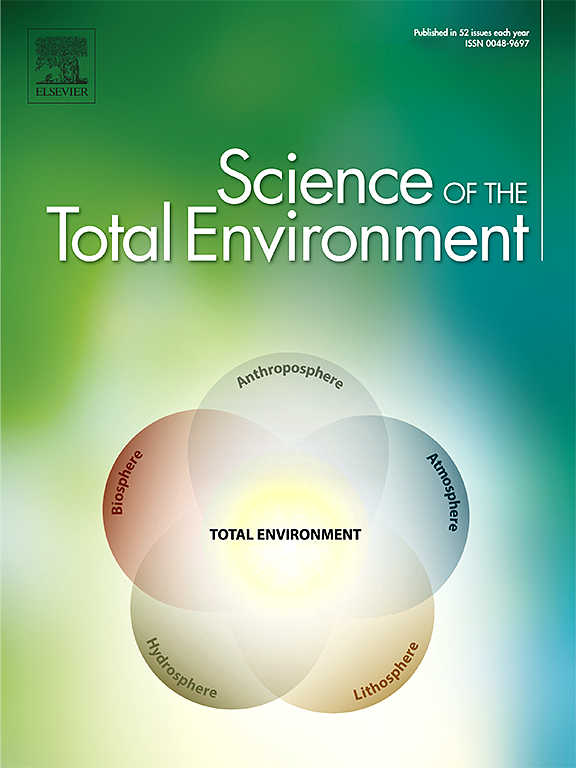Permeable pavement blocks as a sustainable solution for managing microplastic pollution in urban stormwater
IF 8
1区 环境科学与生态学
Q1 ENVIRONMENTAL SCIENCES
引用次数: 0
Abstract
Permeable pavement systems (PPS) designed to store stormwater and facilitate its drainage into pipeline networks also provide the added advantage of retaining particulate pollutants in the stormwater runoff. Among these pollutants, microplastics (MPs), are increasingly being detected in the atmosphere and can be deposited in the environment via rainfall. Consequently, mitigating the transport of airborne MPs through rainfall is crucial for preventing water and soil contamination, thereby reducing the potential risks to human health and ecosystems. To achieve effective pollution control, an experimental study was conducted to assess MPs removal efficiencies and permeability performance of various permeable pavement blocks. The pore structure, which is a critical factor influencing permeability, was analyzed using porosity measurements and X-ray computed tomography imaging. Additionally, computational fluid dynamics (CFD) simulations were utilized to investigate the MPs removal mechanisms within the PPS, modeling the flow of MPs through blocks with distinct pore structures and varying permeability levels. Notably, Block A, with the highest permeability (1.7 mm/s), achieved removal efficiencies exceeding 90 % for polyethylene (PE) and polyethylene terephthalate (PET). CFD analysis revealed that low-density PE particles were retained more effectively, while high-density PET particles displayed greater mobility through the pavement blocks. Furthermore, as rainfall intensity increased, the removal efficiencies of PE and PET gradually decreased. This study highlights the critical role of material design and CFD-optimised pore structures in enhancing the efficacy of permeable pavement systems for urban stormwater management. By elucidating the MPs removal mechanisms driven by distinct transport behaviors of PE and PET particles based on density differences, these systems offer a promising solution for mitigating urban stormwater contamination and advancing sustainable water resource management.

透水路面砌块作为管理城市雨水中微塑料污染的可持续解决方案
透水路面系统(PPS)的设计目的是储存雨水,并方便其排入管网,也提供了额外的优势,以保留雨水径流中的颗粒污染物。在这些污染物中,微塑料(MPs)越来越多地在大气中被检测到,并可以通过降雨沉积在环境中。因此,减少通过降雨在空气中传播的MPs对于防止水和土壤污染至关重要,从而减少对人类健康和生态系统的潜在风险。为了实现有效的污染控制,进行了一项试验研究,评估了不同透水路面块的MPs去除效率和透水性能。孔隙结构是影响渗透率的关键因素,利用孔隙度测量和x射线计算机断层成像技术对孔隙结构进行了分析。此外,利用计算流体动力学(CFD)模拟来研究PPS内MPs的去除机制,模拟MPs在具有不同孔隙结构和不同渗透率水平的区块中的流动。值得注意的是,区块A具有最高的渗透率(1.7 mm/s),对聚乙烯(PE)和聚对苯二甲酸乙二醇酯(PET)的去除效率超过90%。CFD分析显示,低密度的PE颗粒更有效地保留,而高密度的PET颗粒在路面块体中表现出更大的流动性。随着降雨强度的增大,PE和PET的去除率逐渐降低。本研究强调了材料设计和cfd优化孔隙结构在提高城市雨水管理透水路面系统效能方面的关键作用。通过阐明基于密度差异的PE和PET颗粒的不同运输行为驱动MPs去除机制,这些系统为减轻城市雨水污染和推进可持续水资源管理提供了一个有希望的解决方案。
本文章由计算机程序翻译,如有差异,请以英文原文为准。
求助全文
约1分钟内获得全文
求助全文
来源期刊

Science of the Total Environment
环境科学-环境科学
CiteScore
17.60
自引率
10.20%
发文量
8726
审稿时长
2.4 months
期刊介绍:
The Science of the Total Environment is an international journal dedicated to scientific research on the environment and its interaction with humanity. It covers a wide range of disciplines and seeks to publish innovative, hypothesis-driven, and impactful research that explores the entire environment, including the atmosphere, lithosphere, hydrosphere, biosphere, and anthroposphere.
The journal's updated Aims & Scope emphasizes the importance of interdisciplinary environmental research with broad impact. Priority is given to studies that advance fundamental understanding and explore the interconnectedness of multiple environmental spheres. Field studies are preferred, while laboratory experiments must demonstrate significant methodological advancements or mechanistic insights with direct relevance to the environment.
 求助内容:
求助内容: 应助结果提醒方式:
应助结果提醒方式:


